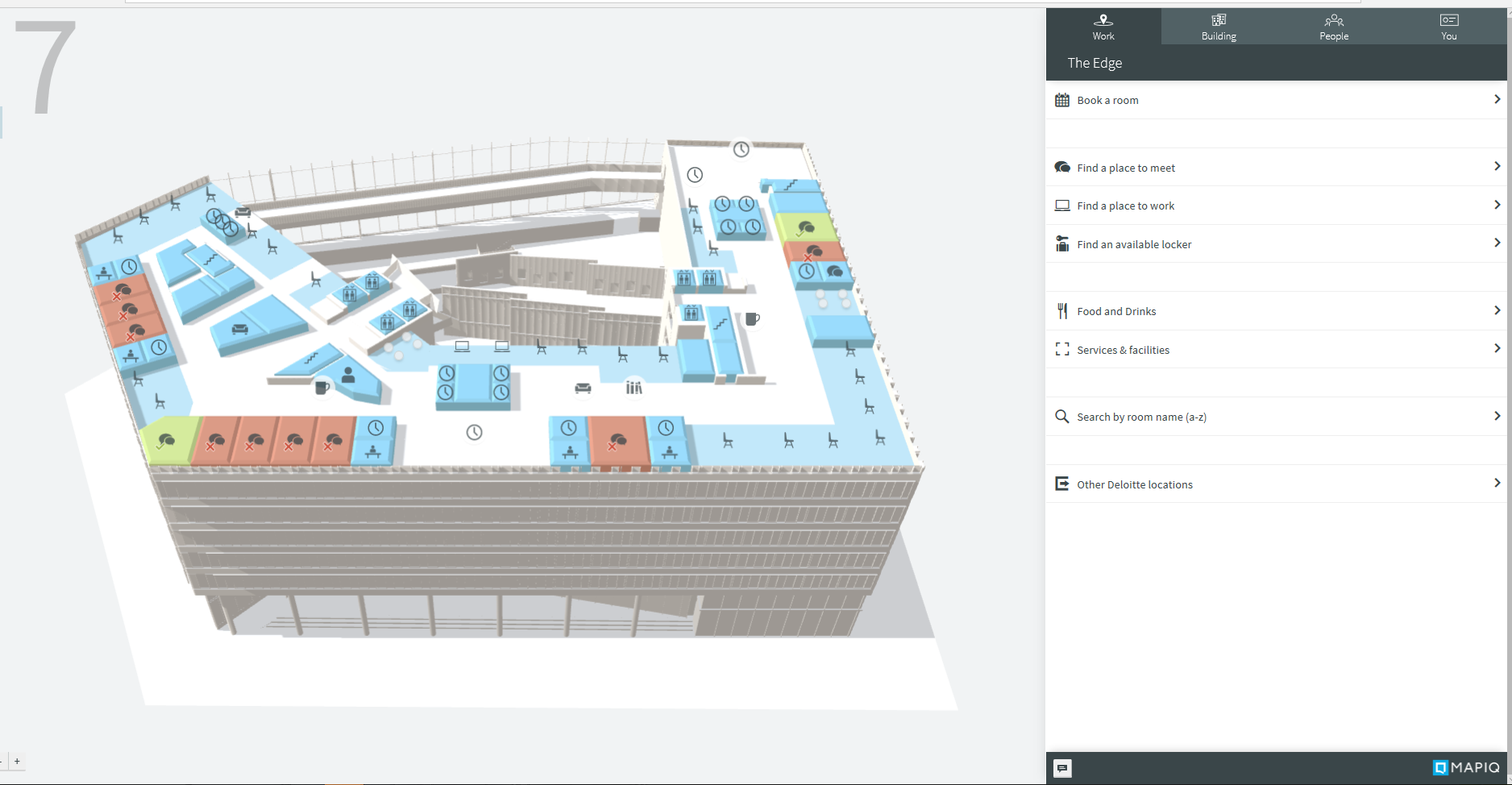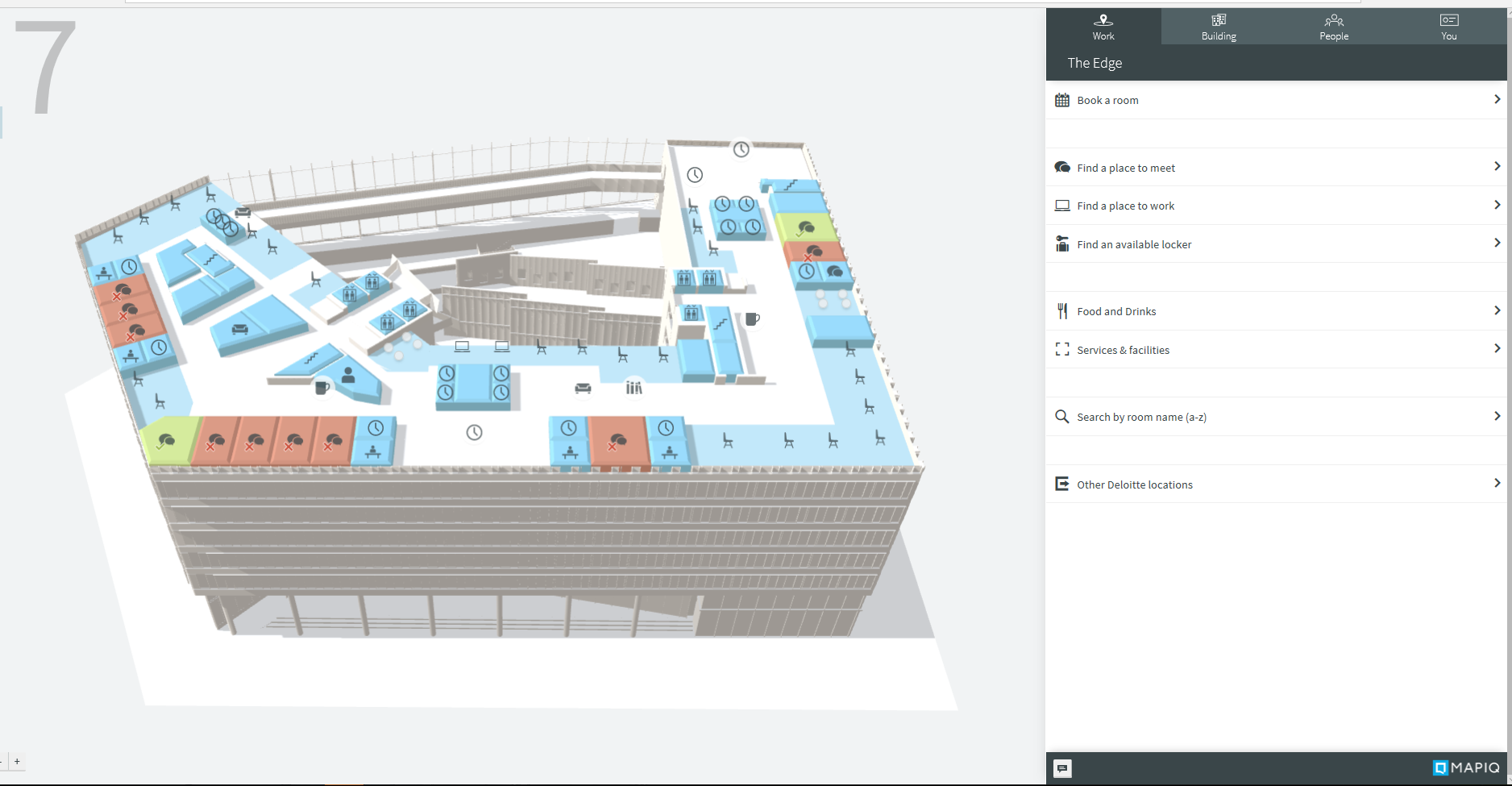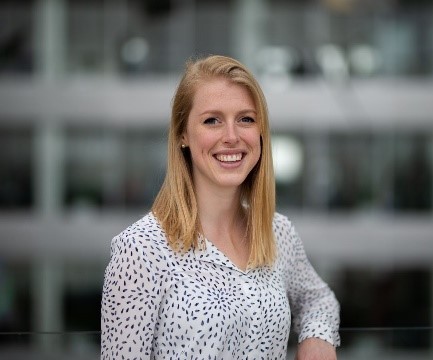The Edge – Why did we develop it?
Editie: 26
Published on: 22 januari 2019
In a series of three articles, Lisa zooms into smart & connected office buildings from a Corporate Real Estate end-user perspective. The first article is about the deeper meaning of being ‘smart & connected’ and the move from owning assets to asset-as-a-service. The second articles explains more about the reasons for Deloitte to co-develop The Edge and why it was so important for the building to not just be sustainable, but also smart & connected. The last article tells more about the next steps our CRE department is taking together with our Consulting colleagues to optimize the building’s usage and user experience: The Edge 2.0.
In een serie van drie artikelen, zoomt Lisa in op smart & connected kantoorgebouwen vanuit een vastgoed eindgebruiker perspectief. Het eerste artikel gaat over de diepere betekenis van ‘smart & connected’ en het verschuiven van de markt van bezit naar as-a-service. Het tweede artikel vertelt meer over de redenen voor Deloitte om The Edge mede te ontwikkelen en waarom het zo belangrijk was dat het gebouw niet alleen duurzaam, maar ook smart & connected zou worden. Het laatste artikel legt uit wat de volgende stappen zijn die de CRE afdeling, tezamen met onze Consulting collega’s, neemt om het gebruik en de gebruikerservaring van het gebouw verder te optimaliseren: The Edge 2.0.
A Corporate Real Estate end-user perspective
Why did a professional services firm decide to co-develop The Edge with the real estate technology firm OVG? And why was it so important for the end-user that the office building would not only be sustainable, but also smart and connected? The answers to these questions relate to the transformation of businesses in general, and the evolution of Deloitte as a firm. The world of work is fundamentally changing, impacting companies from all sizes, shapes and forms.
As a core business, Deloitte helps organizations around the world to recalibrate their talent, technology, real estate and workplace strategies. With a variety of global alliances, quite some research is published on for example: What do millennials want from their employer and workplace? What is the impact of industry 4.0, robotics and artificial intelligence on businesses? And, how can organizations prepare for this digital future? Several years ago, the decision was made to also reflect this research upon the firm itself, in order to define the future strategy and organization.
For Deloitte, as well as for most other companies, the core-business has changed quite a bit over the past 20 years. From being a traditional Audit practice, the organization changed to become a Consulting firm. While in 2000, 80 percent of global revenues originated from Audit services, by 2015 the revenues from Audit and Consulting both had a 50 percent share. It’s estimated that in 2020, 80 percent of revenues will come from Consulting services. Because of this transition of core business, a lot of companies require a completely new employee proposition.
This changes the whole concept of how employees need to be facilitated in offices. If there is a need to attract a different type of talent one must know where these people want to work, how they want to work, with what technology they work and how they will be managed, developed and measured. In most firms, this is all separately written down in the strategies of the HR, IT, CRE and FM department. As these departments don’t always communicate and align their strategies with each other, they may not always have the same goals, or sometimes even conflicting goals.
Before developing The Edge, Deloitte Netherlands established an integral workplace strategy, connecting the HR, IT, CRE and FM departments to collectively define what was needed for the new Headquarters in Amsterdam. To give a practical example: the new workforce was becoming more agile, as consultants travel a lot and work at the client’s office approximately 75 percent of the time, whereas audit, tax and financial advisory employees usually work at their own office 40-75 percent of the time. Workforce agility was therefore a part of the HR strategy. However, this also impacts IT: phones and laptops with a 4G connection were needed, so that consultants could work everywhere and anytime they want.

Table 1: Desk sharing ratio based on actual utilization rates
From a Corporate Real Estate perspective, this also meant that a large number of employees would not always be at the office and therefore, the CRE footprint could be optimized. In addition, communication technology was needed from IT to collaborate with colleagues from a distance and a new workplace vision was needed to facilitate a more flexible, activity-based way of working, as well as other activities such as teaming and networking.
This illustrates that, while five years ago, office portfolio management was all about cost reduction, hot-desking and ensuring that our resources were fully utilized, offices are now viewed differently. If you can work any time and any place you want to, why come to the office? Office space is increasingly about meeting up with colleagues and using the space creatively for collaboration, teaming, learning and socializing. Whereas formerly, the office was a place where you had to work, it is now a place where you can work.
Having defined an integral workplace strategy for The Edge, it was necessary to determine the type of spaces, facilities and features to incorporate in the Edge. A tool called User Journey Mapping was used to detail out the program of requirements for The Edge. This tool was originally developed by Deloitte Digital, and used for software development. Instead of developing software solely for its functionality, User Journey Mapping begins with the user in mind: As <<persona>> I want <<what>> so that I can <<why>>. For example: as an employee, I want to know where there’s a free parking spot, so that I can easily park my car when I get to work.
User Journey Mapping was used to find experience-driven solutions for The Edge by mapping a day at the office for 60 pre-defined personas. This mapping included all their moments of interaction with the building and it’s features. For each moment of interaction, it was defined what the persona liked and/or disliked. Based on this overview, the program of requirements for The Edge was determined, including all facilities and systems that were demanded for the building.
The 60 different personas were categorized into three perspectives: the employee experience, client experience, and agile operations (e.g. facility services). One of the most important results of the journey mapping was the office app, developed by the Delft-based start-up Mapiq. The interactive 3D map gives users the ability to navigate through the office, find available workplaces or lockers, locate their colleagues and book meeting rooms. In each meeting room, the app is used to operate presentation screens, AV and sunshades.

Figure 1: All meeting rooms and workspaces are visualized in Mapiq
Even though before and during development of the Edge, a lot of time and effort was invested in its technology features, in practice some things did not turn out to be as expected. After moving in and actually occupying The Edge, it was noticed that the users actually have much more wishes and needs that would further improve their daily work experience. Some want to be able to see when the cafeteria is busy, to adjust their lunch schedule to the peak hours. Others want to make sure that meeting rooms are automatically freed up when reserved but not used, or want to receive a signal 10 minutes before the meeting reservation ends, so they can round it up on time, before colleagues are knocking on the door.
Based on input from daily users of The Edge, the office app and other technology features of the building are currently being improved in a project called The Edge 2.0, which is a collaboration of Deloitte Digital, Real Estate Consulting and IT & Workplace Services. Read more about The Edge 2.0 in the next article of The Edge series…
The Edge – Waarom hebben wij het ontwikkeld?
Vanuit het perspectief van een vastgoed eindgebruiker
Waarom is er besloten om samen met vastgoedtechnologie firma OVG The Edge te co-creëren? En waarom is het zo belangrijk dat het kantoorgebouw niet alleen duurzaam, maar ook “smart” is? De antwoorden op deze vragen staan in verband met de evolutie van bedrijven in het algemeen en de transformatie van Deloitte. Overal om ons heen verandert het concept “werk” fundamenteel, wat een impact heeft op bedrijven van alle verschillende formaten.
Deloitte’s voornaamste taak naar organisaties toe is het herijken van hun talent, technologie, vastgoed en werkplek strategieën. Samen met internationale partners wordt er heel wat onderzoek gedaan naar bijvoorbeeld; wat verwachten millennials van hun werkgever en werkplek? Wat is de invloed van industry 4.0, robotica en kunstmatige intelligentie op bedrijven? En hoe kunnen bedrijven zich het beste voorbereiden op deze digitale toekomst? Een aantal jaar terug werd het besluit genomen om aan de hand van zelfreflectie op basis van deze onderzoeken de toekomststrategie te bepalen.
Voor Deloitte, evenals voor vele andere bedrijven, is de core business de laatste 20 jaar behoorlijk veranderd. Van een traditioneel accountancy bedrijf is het getransformeerd naar een adviesbureau. Waar in 2000 nog 80 procent van de wereldwijde winst vanuit Audit diensten werd gegenereerd, was dit in 2015 nog 50 procent. Er wordt geschat dat in 2020, maar liefst 80 procent van de winst vanuit de adviestak komt. Door deze transitie in core business, is er bij veel bedrijven een volledige nieuw werknemerspropositie nodig.
Dit verandert het hele concept van hoe medewerkers worden gehuisvest in de kantoren. Nu het noodzakelijk is om een ander type talent aan te trekken, is het van belang om te weten waar deze mensen werken, hoe ze willen werken, met welke technologie en hoe zij gemeten, ontwikkeld en gemanaged worden. Bij de meeste bedrijven, wordt dit onafhankelijk van elkaar opgeschreven in verschillende strategieën van de HR, IT, CRE en FM afdeling. Aangezien deze afdelingen niet altijd met elkaar communiceren en op een lijn zitten met hun strategie, kunnen ze verschillende dan wel conflicterende doelen voor ogen hebben.
Voor de ontwikkeling van The Edge is een integrale werkplekstrategie opgezet die de HR, IT, CRE en FM afdeling aan elkaar verbond, zodat zij samen konden bepalen wat er nodig was op het hoofdkantoor in Amsterdam. Om een praktisch voorbeeld te geven: Er werd geconstateerd dat het personeelsbestand steeds meer flexibel werd, omdat consultants veelal reizen en werken 75 procent van de tijd op het kantoor van de klant, terwijl audit, tax en financial advisory werknemers zo’n 40-75 procent van de tijd op hun eigen kantoor werken. Flexibiliteit van het personeelsbestand maakte daarom ook onderdeel uit van de HR strategie. Anderzijds had dit ook invloed op IT: telefoons en laptops met een 4G connectie waren nodig, zodat consultants waar en wanneer dan ook konden werken.

Tabel 1: Bureauverdeling gebaseerd op bezettingsgraden
Vanuit een vastgoed perspectief, betekende dit ook dat een groot aantal van de werknemers niet altijd op het kantoor aanwezig zouden zijn en zodoende kon de voetafdruk van het kantorenportfolio worden geoptimaliseerd. Bovendien was er communicatietechnologie nodig vanuit IT om samen te werken met collega’s op afstand. Ook was er een nieuwe werkplekvisie nodig om deze meer flexibele en activiteit-gerichte werkwijze te faciliteren, inclusief nevenactiviteiten als teambuilding en netwerken.
Dit voorbeeld laat zien dat waar vijf jaar terug het management van een kantorenportfolio voornamelijk focuste op het drukken van kosten, hot-desking en het optimaal gebruik van de middelen, er nu heel anders naar kantoren gekeken wordt. Als het mogelijk is overal en wanneer dan ook te werken, wat brengt werknemers dan nog naar het kantoor? De kantoorruimte wordt meer en meer een ontmoetingsplek dan een echte werkplek. Vroeger moest men werken op kantoor, nu kan men werken op kantoor.
Nadat een integrale werkplekstrategie voor The Edge was vastgesteld, was het vervolgens van belang de types ruimte, faciliteiten en technologieën in The Edge te definiëren. Om het programma van eisen tot in detail uit te werken werd een tool gebruikt genaamd User Journey Mapping. Van origine is deze tool ontwikkeld door Deloitte Digital en wordt hij gebruikt voor o.a. software ontwikkeling. User Journey Mapping begint vanuit het oogpunt van de gebruiker: Als <<persona>> wil ik<<wat>> zodat ik <<waarom>>. Bijvoorbeeld: als werknemer wil ik weten waar een vrije parkeerplek is, zodat ik makkelijk kan parkeren als ik op het werk aankom.
User Journey Mapping werd gebruikt om ervaring-gedreven oplossingen voor The Edge te vinden door het in kaart brengen van een kantoor voor 60 van tevoren vastgestelde fictieve persona’s en al hun momenten in van interactie met het gebouw en diens functies. Voor elk moment van interactie, werd gedefinieerd of dit het persona beviel of niet. Op basis hiervan, werd het programma van eisen voor The Edge vastgesteld, inclusief alle faciliteiten en systemen die nodig waren voor het gebruik van het gebouw.
De 60 verschillende persona’s werden gecategoriseerd in drie perspectieven: de werknemerservaring, de klantervaring en de operationele ervaring (o.a. facility management). Een van de meest belangrijke resultaten van de User Journey Mapping exercitie was de kantoorapp; deze interactieve 3D app kan gebruikers helpen met navigatie door het kantoor, het vinden van werkplekken, kluisjes of collega’s en het reserveren van vergaderruimtes. In elke vergaderruimte wordt dezelfde app gebruikt voor het opereren van o.a. de beeld- en zonneschermen.

Figuur 1: Alle vergaderruimtes en werkplekken gevisualiseerd in Mapiq
Gedurende de ontwikkeling van The Edge is veel tijd en moeite geïnvesteerd in de technologieën in het gebouw, maar toch waren er enkele dingen die anders werkten in de praktijk. Na het intrekken in The Edge, werd geconstateerd dat gebruikers van het gebouw meer wensen en behoeftes hebben die hun dagelijkse werkervaring zouden verbeteren. Sommigen zouden willen zien of het druk is in de cafetaria om daar hun lunchschema op aan te passen. Anderen willen dat vergaderruimtes automatisch vrijgegeven worden wanneer deze gereserveerd zijn maar niet worden gebruikt, of willen een melding krijgen vlak voordat de meeting eindigt, zodat ze op tijd kunnen afronden.
Gebaseerd op de input van gebruikers van The Edge, wordt er op dit moment een verbeterde kantoorapp ontwikkeld en worden vele technologieën ge-upgrade of nieuw geïnstalleerd in het project genaamd The Edge 2.0. Hierover meer in het laatste artikel van The Edge series….
Mail the editors
